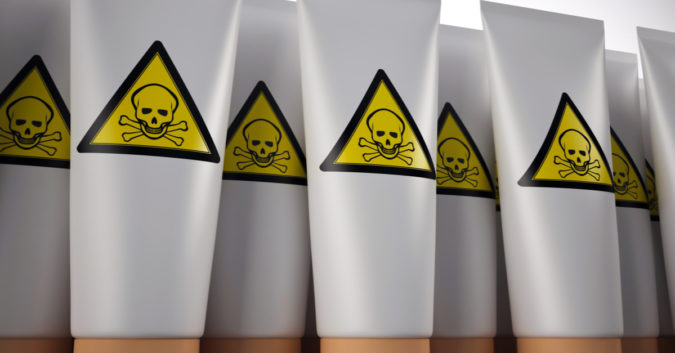Asbestos-tainted talc. We hear about it in the news seemingly on a daily basis: Talc lawsuit verdicts totaling in the millions of dollars, teens being exposed to asbestos in children’s makeup kits, and consumers allegedly getting cancer from repeatedly using Johnson’s Baby Powder®.
It’s all enough to make your head spin.
Back in Sept. 2018, the U.S. Food and Drug Administration (FDA) contracted the nation’s leading laboratory for asbestos testing in talc-based products, AMA Analytical Services, Inc. The FDA tasked AMA with testing popular cosmetics products that list talc as a primary ingredient.
After 18 months of continuous lab work, AMA’s test results were released by the FDA in a “final report” on March 9. The data show that 9 of the 52 total cosmetics products tested were positive for asbestos, or nearly 20 percent.
The non-profit Environmental Working Group (EWG) has been instrumental in relaying this vital information to the public.
About AMA’s test results, EWG Senior Vice President for Government Affairs Scott Faber stated:
“A .200 batting average in baseball is borderline bad, but it’s downright deplorable when it comes to asbestos in cosmetics. The results of FDA’s tests should be all the evidence needed for Congress to act quickly to pass legislation mandating all talc-based personal care products are rigorously tested and the cosmetics industry is required to put the public’s safety first.”
To date, in spite of numerous efforts to impose such legislation, Congress has made no progress on the matter.
Talc-Based Cosmetics Need Their Day in Congress
Among consumers, national concern over the presence of asbestos in talc-based cosmetics is rising.
Over the past few years, several high-profile cases involving asbestos-tainted cosmetics have made consumers uneasy about the prospect of purchasing such products, especially for their children.
In March 2019, the FDA found asbestos in 3 separate products sold by the popular teen retail chain Claire’s. Three months later, in June 2019, the FDA issued another warning, requesting that consumers steer clear of 2 additional makeup sets sold at Claire’s.
These incidents are only 2 of the most recent. In addition to children’s makeup sets, asbestos-tainted talc has also been identified in facial powders, eye shadow, adult makeup, and baby powder.
In March 2019, Rep. Debbie Dingell (D-MI) introduced a House bill that would require the manufacturers of talc-based cosmetic products to prove that their products are free of asbestos through rigorous testing. According to the bill, if manufacturers cannot prove their products are free of asbestos, they would be required to add a warning label declaring so.
In the best interest of public health, it is vital that Congress act on this bill and make it a reality.
Talc and Asbestos: A Dangerous Marriage
Talc is the softest known mineral in the world. Ever since the large-scale commercial incorporation of talc into products like Johnson’s Baby Powder (which has been around since the late 19th century), it has become a mainstay in American and global consumerism.
The problem is: Talc and asbestos, both of which are natural minerals mined from certain metamorphic rock formations, occur in nature together.
Once the talc has been mined it can easily become contaminated by asbestos. When the minerals are then ground into fine powders, it can be extremely difficult to separate the two and offer a “100% pure talc” product, devoid of any and all asbestos contamination.
Generally speaking, asbestos is fairly well-known by the public to be a carcinogen — one that can lead to the devastating and difficult-to-treat cancer called “mesothelioma.” Mesothelioma always comes with a poor prognosis and there is no known cure. Treatments can sometimes help extend lives for a short period, but the cost is often staggering for the average American.
Domestic, foreign, and global health agencies, such as the Occupational Health and Safety Administration (OSHA) and the World Health Organization (WHO), have repeatedly stated there is “no safe level of asbestos exposure.”
So, why, then, is asbestos still legal to import and use in the United States? That’s a great question. It shouldn’t be.
The last time asbestos was banned in the U.S. it was 1989. The ban was reversed in 1991 due to aggressive congressional lobbying efforts on behalf of Big Business. Meanwhile, in the developed world, over 60 nations have banned asbestos outright, including most of western Europe.
Ban Now: Legal Asbestos Kills Thousands of Americans Each Year
Roughly 3,000 new cases of mesothelioma are diagnosed in the U.S. every year. Even one new diagnosis is one too many for a disease that is entirely preventable.
The EWG has consistently maintained that the overall annual death toll from asbestos — from both mesothelioma and other asbestos-related diseases, such as asbestos-related lung cancer and asbestosis — is 12,000-15,000 Americans.
Other studies have pegged the number even higher, at upwards to 40,000 Americans, which would put asbestos within reach of the top-10 causes of death in America, just after influenza, kidney disease, and suicide.
The numerical data is so clearly disturbing, which makes all the years of federal inaction on behalf of Congress and the EPA even more appalling.
Around the country, 19 state Attorneys General have signed a letter to U.S. House Speaker Nancy Pelosi urging the House of Representatives to act on bill H.R. 1603. The bill, known more informally as the Alan Reinstein Ban Asbestos Now Act (ARBAN), calls for a complete and total ban of the mineral in the United States.
Thirty years ago, America had the courage to step up and ban asbestos — a mineral with clear and deadly exposure risks — and now, we must ask ourselves: Where has that courage gone?
